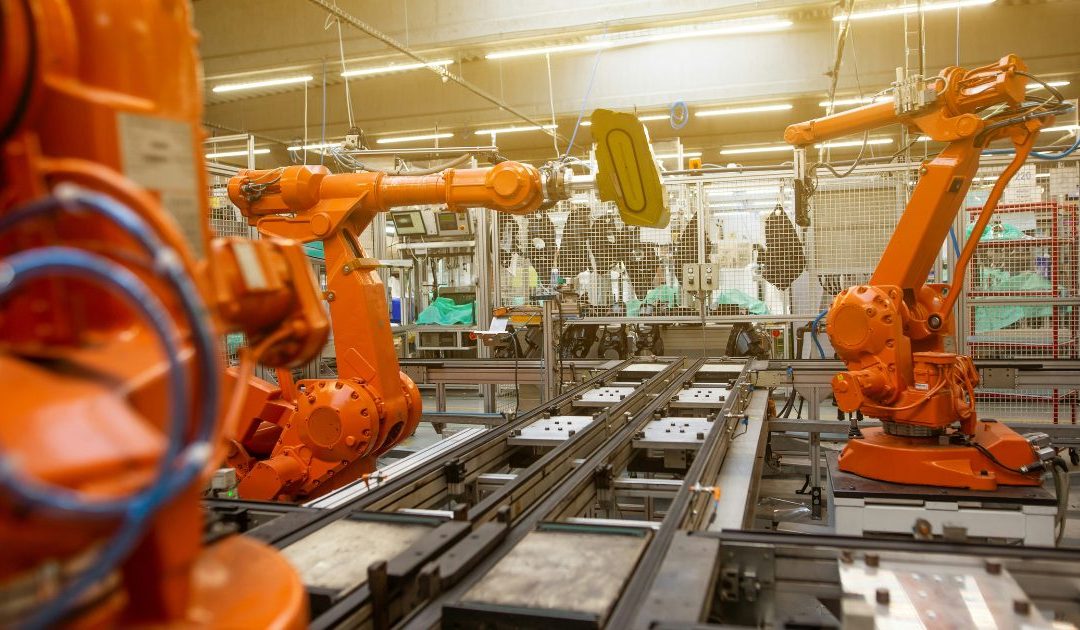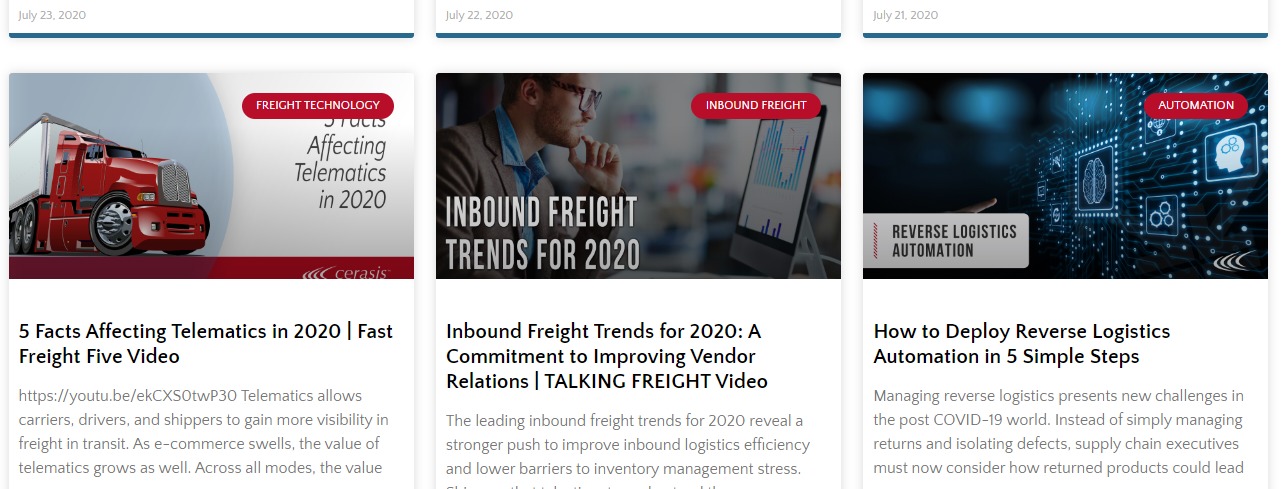
by Fronetics | Aug 5, 2024 | Blog
Nearly ubiquitous in every day business conversation, artificial intelligence (AI) now touches virtually every market sector. However, its impact on supply chain management has been particularly interesting to watch.
AI isn’t just changing supply chain management; it’s revolutionizing it. Nearly three-quarters of supply chain companies reported using AI in some form in a 2024 McKinsey survey. From improved forecasting and optimization to enhanced risk management and sustainability, AI is helping businesses create more efficient, resilient, and responsive supply chains.
The AI Revolution in Supply Chain Management
Artificial intelligence isn’t just a buzzword in supply chain management; it’s a game-changer. It’s reshaping how businesses manage their supply chains. What is AI doing to transform supply chain management?
1. Unparalleled Demand Forecasting
One of the most significant advantages AI brings to supply chain management is its ability to predict demand with unprecedented accuracy. By analyzing vast amounts of historical data, market trends, and external factors, AI algorithms can forecast demand patterns more precisely than ever before. This enhanced forecasting ability helps companies:
- Optimize inventory levels
- Reduce waste
- Improve customer satisfaction by ensuring product availability
2. Intelligent Inventory Management
AI doesn’t stop at predicting demand; it also revolutionizes inventory management. Machine learning algorithms can:
- Continuously adjust inventory levels based on real-time data
- Optimize stock levels across multiple locations
- Reduce carrying costs while minimizing stockouts
This level of intelligent inventory management leads to significant cost savings and improved efficiency.
3. Predictive Maintenance: Reducing Downtime
In supply chain operations, equipment downtime can be costly. AI-powered predictive maintenance is changing this landscape by:
- Analyzing sensor data to predict when equipment is likely to fail
- Scheduling maintenance before breakdowns occur
- Extending asset lifespans through timely interventions
The result? Reduced downtime, lower maintenance costs, and improved operational reliability.
4. Route Optimization: Enhancing Logistics Efficiency
For businesses involved in transportation and logistics, AI offers powerful route optimization capabilities. AI algorithms can:
- Calculate the most efficient routes in real-time
- Factor in variables like traffic, weather, and fuel costs
- Reduce transportation costs and improve delivery times
This not only saves money but also enhances customer satisfaction through faster and more reliable deliveries.
5. Automated Warehousing: The Future of Fulfillment
AI is transforming warehouse operations through automation. AI-powered robots and systems can:
- Streamline picking and packing processes
- Improve order fulfillment speed and accuracy
- Reduce labor costs and human error
These advancements are particularly crucial in the era of e-commerce and same-day delivery expectations.
6. Proactive Risk Management
Supply chain disruptions can have severe consequences. AI helps businesses stay ahead of potential issues by:
- Analyzing various data sources to identify potential risks
- Providing early warnings about supplier issues, geopolitical events, or natural disasters
- Enabling proactive risk mitigation strategies
This proactive approach enhances supply chain resilience and business continuity.
7. Dynamic Pricing Strategies
AI algorithms can adjust pricing in real-time based on various factors, including:
- Current demand and supply levels
- Competitor pricing
- Market conditions
This dynamic pricing capability helps businesses maximize revenue and maintain competitiveness in volatile markets.
8. Enhanced Quality Control
Quality issues can be costly and damaging to a brand’s reputation. AI, particularly computer vision and machine learning, can:
- Detect product defects more quickly and accurately than human inspectors
- Identify patterns that may lead to quality issues
- Improve overall product quality and reduce recalls
9. End-to-End Supply Chain Visibility
One of the most valuable contributions of AI to supply chain management is its ability to provide comprehensive visibility. AI can:
- Integrate data from various sources across the supply chain
- Provide real-time insights into every aspect of operations
- Enable better-informed decision-making at all levels
This end-to-end visibility is crucial for identifying inefficiencies and optimizing the entire supply chain.
10. Driving Sustainability in Supply Chains
As businesses focus more on sustainability, AI is playing a crucial role. It can:
- Optimize operations to reduce waste and energy consumption
- Identify opportunities for more sustainable practices
- Help businesses meet their environmental goals while maintaining efficiency
The Future of AI in Supply Chain Management
The potential of AI in supply chain management is vast and still largely untapped. As AI technologies continue to evolve, we can expect even more innovative applications that will further transform the industry. The COVID-19 pandemic highlighted the need for more agile and robust supply chains, accelerating interest in AI solutions. Businesses that embrace AI in their supply chain operations are likely to gain a significant competitive advantage in the years to come.
In fact, as we move forward, the integration of AI in supply chain management will likely become not just an advantage, but a necessity for businesses looking to thrive in an increasingly complex and competitive global marketplace.

by Jennifer Hart Yim | Aug 28, 2020 | Blog, Logistics, Talent
Digital supply chain management requires a whole new set of skills. From an omnichannel mindset to enterprise IT use, here’s what defines success of logistics leaders.
Editor’s note: This is the final guest post in a three-part series by Kate Began of Polycase.
It took some time for the tech revolution to hit the logistics industry, but now that it’s here, everything is changing rapidly. Suddenly, it’s all about omnichannel commerce, digital transparency, and advanced analytics (among many other trends). And as the world of logistics changes, the leaders of the logistics industry will have to develop new skills with which to navigate it.
What skills will the logistics leaders of tomorrow (and today) need to effectively manage the new realities of the supply chain? These seven areas will define the success of a business’s digital supply chain operations and separate the organizations that can fuel their success with technology from the ones who must struggle to adapt to it.
To manage the digital supply chain, here are 7 skills logistics leaders need
1. Ability to adapt
Twenty-first-century logistics will require its leaders and managers to constantly learn how to use new tools and react to changing market conditions. The new logistics professional has to keep a steady hand at the tiller during times of big change and use solid data analysis to find the right path forward, even when market conditions aren’t perfectly clear.
Flexibility will be incredibly important in implementing the most cutting-edge logistics technologies such as logistics blockchain, automation, and IoT. But it’s also critical to the daily operations of logistics when it comes to filling in transportation gaps and devising on-the-spot solutions to problems. The logistician who can harness the new digital tools for these ends will be formidable indeed.
2. Proactive curiosity
Adaptation is easier when a business pursues the right new tech, rather than waiting for it to come to them. Good logistics management will also increasingly require a commitment to proactively keeping up with technological and industry trends.
The 21st-century logistician has to be well-versed in everything from industry white papers to what’s trending among logistics professionals on LinkedIn. They need to be able to spot key trends and prepare for them so that businesses can stay ahead of the curve and not get blindsided by major changes.
3. Strategic thinking
Thinking two steps ahead can be tough when the business environment is changing so rapidly, but that’s what the new millennium logistics professional has to do. They have to take the long view and keep a business’s core principles at heart when creating plans for the future.
The need for strategic thinking also means tempering enthusiasm for new tech with good judgment and analytical rigor. Unwise investment in unproven or poorly-implemented technologies can be just as disastrous for a supply chain as lagging behind in tech, so as always, there’s no substitute for clear-eyed analysis and solid planning.
4. Enterprise IT use and procurement
Enterprise IT is an increasingly critical skill set for logistics professionals. Almost all logistics companies now use enterprise IT software, such as ERP suites, to manage their supply chains, and digital logistics professionals must often make decisions about procurement and implementation of these sophisticated software products.
Knowing how to get all of these disparate technologies to work together can be an even more difficult and necessary skill. Cross-platform performance can require knowledge of APIs and other tools that have been foreign to the logistics industry until now. Much of today’s logistics software is also cloud-based, so it’s also useful to know the basic principles of SaaS architecture and cloud workflows.
5. Project management
Today’s logistics professional often has to assume leadership roles on major projects. In order to be an effective leader, they must be skilled at tasks such as:
● Identifying the strengths and weaknesses of team members and delegating tasks to them effectively
● Working with upper management to structure project calendars and deadlines
● Estimating costs and planning for the budgeting and deployment of resources
● Identifying key technological tools for driving project success
● Creating transparency at all levels of the project by deploying appropriate digital tools such as IoT sensors and shipment tracking
Twenty-first century logistics concentrates more operational and computing power in every employee’s hand than ever before—but that power only produces results when employees are managed properly by a competent project manager.
6. People skills
Speaking of managing people, logistics professionals must also remember that not everything in the digital supply chain is run by circuits in a plastic enclosure. On the contrary, old-fashioned people skills are as necessary in the logistics industry as they’ve ever been—perhaps even more so.
Supply chains now have more stakeholders than ever, and effective management requires communicating effectively with a wide variety of personalities and roles. A good supply chain manager will be able to use 21st-century communication tools to connect people and make sure everyone’s on the same page, but they must also be fluent in the “soft skills” of empathy and interpersonal contact.
Empathy also requires a zero-tolerance mindset for regressive elements like sexism and racism in the digital workplace. Logistics may not be HR, but much of the everyday work of combating prejudice is done at the ground level by managers. For a business to attract and retain the best talent, they must pursue an egalitarian vision that makes work a great place to be for everyone.
7. An omnichannel mindset
Business, both B2C and B2B, now flows through a multitude of channels. That means that for the 21st-century logistics professional, an omnichannel mindset is a must-have. Whoever your customers are, they’re now on mobile phones, tablets and even voice command services like Alexa. A business’s platform and its logistics operations must reflect this new reality.
The rise of omnichannel commerce means that logistics operations must find a way to interlock with every channel that’s important to a business. That means keeping in mind how channels such as brick-and-mortar stores, traditional online sales and mobile shopping are all distinct but interrelated and managing them with an eye toward keeping every part of the complex interplay running smoothly.
There’s no running away from the oncoming wave of disruptive technology in the digital supply chain, so the only option is to ride it. Logistics professionals who are flexible, curious and empathetic will have the best capability for managing these new realities and turning them into a profitable and efficient future.
Kate Began serves as the Sales and Marketing Manager for Polycase. She oversees the customer service representatives, assists with product development, and leads the marketing efforts from the Avon, Ohio headquarters.
Read more:
When short on time, updating old blog posts for SEO makes a lot of sense
5 ways Covid-19 has already changed American manufacturing
Stop hibernating: You’re missing out on company blog benefits

by Jennifer Hart Yim | Aug 21, 2020 | Blog, Supply Chain, Talent
Editor’s note: This is the second in a series of three guest posts by Kate Began of Polycase.
The increasing digitization of commerce has revolutionized global supply chains in all kinds of ways. Shipments can now be dispatched with the click of a button, sophisticated algorithms can automatically route truckers around traffic jams, and goods can be imported and exported more quickly and easily than ever.
To handle all of those big changes and ensure that today’s supply chains keep up with the times, a new career has been born: the digital supply chain manager. This relatively new career is taking off fast. So, what’s it all about? Today, we’ll talk about what a career as a digital supply chain manager entails, how to enter this in-demand field, and even why some supply chain management jobs may be totally different from what you expect.
What exactly does a digital supply chain manager do?
Duties
Digital supply chain managers are responsible for helping businesses implement the tools of 21st-century logistics in their supply chains. It’s all about keeping one foot in the bold new frontiers of the digital world and one foot in classic business acumen. The goal? Breaking down walls and silos, and creating a more efficient and integrated process.
The job of a digital supply chain manager usually includes tasks such as:
- Using predictive analytics tools and automated replenishment to more effectively meet businesses’ inventory needs
- Managing the operation and implementation of software systems such as ERP suites and digital logistics platforms
- Helping businesses integrate their eCommerce platforms with their operations on the ground
- Deploying IoT devices and automation in innovative and cost-effective ways digital supply chain management jobs may be totally different from what you expect.
- Analyzing data collection practices and finding new ways to collect the data that matters
- Ensuring that all elements of the supply chain, both physical and digital, are secured appropriately
- Devising and implementing strategies for continually improving supply chain technologies and evaluating the latest technological trends
As the digital supply chain continues to evolve, the digital supply chain manager’s duties will continue to do so as well. It’s a career that requires a commitment to rolling with the punches and continually improving one’s own skills.
Qualifications
What kind of qualifications does someone need today to get a job as a digital supply chain manager?
- Education: At a minimum, you’ll probably need a bachelor’s degree from an accredited university, preferably in a subject like supply chain management, business, statistics, or information technology. Of course, a higher degree like an MBA can only help a candidate’s chances.
- Skills: A digital supply chain manager needs to have a working knowledge of key digital logistics tools such as demand forecasting software, trucker load boards, route planning software and major ERP software suites. But it’s important to remember that a good digital logistics manager’s skills don’t live inside the plastic enclosure of any of their many devices. At the end of the day, it comes down to a candidate’s ability to plan, prioritize and forge meaningful connections with other stakeholders.
- Experience: Entry-level jobs in the digital supply chain management field often include jobs such as logistics analysis, customer service, procurement coordinators, and buyers. Digital supply chain management is a field in which experience and skills are king, so someone with a long history of success in the field may be a competitive candidate even without an advanced degree.
Job outlook
With supply chains expanding and digitizing every day, the job market outlook for digital supply chain managers is fairly strong. The Bureau of Labor Statistics (BLS) predicts job growth of 5 percent (or about as fast as an average career path) for logisticians of all kinds, but there’s good reason to think that digital supply chain management will be a fast-growing subset of that career.
That’s because, as eCommerce continues to create the new realities of the market, the BLS also predicts continued strong growth in all kinds of industries adjacent to eCommerce. And as businesses attempt to compete (or work alongside) eCom behemoths like Amazon and Walmart, the demand for logistics professionals who can navigate the digital supply chain is likely to remain high.
How about average salaries and income? According to BLS data, the average logistician earns around $75,000 per year, which already isn’t too shabby. However, considering the high demand for digital and software skills, digital supply chain managers are likely to earn toward the higher end of the pay scale for their field. And for candidates whose skills include the back-end aspects of software development, the opportunities can be even greater.
The other kind
Depending on who you’re talking to, the phrase “digital supply chain manager” can also refer to a totally different career. The other kind of digital supply chain manager works to coordinate the many aspects of delivering a digital product or service to the consumer.
Think about it: Any app or service that you use goes through a multitude of layers of other software and Web services. From Amazon Web Services to WordPress to cloud security software, this new “digital supply chain” is an essential part of 21st-century commerce. Making sure that every step of the chain is secure and functional is a big job that requires a lot of big-picture thinking and familiarity with a huge variety of technologies.
This kind of digital supply chain management is much more software-focused and can often be done remotely. Essential qualifications skew much more toward the technical side, with degrees and experience in full-stack development, software engineering, computer science, and information technology all offering relevant knowledge.
For those seeking the careers of tomorrow, digital supply chain management is almost certain to have its place among the most critical jobs. Its combination of logistics and sophisticated computer skills isn’t for everyone—but it’s definitely a promising career for those who find that it calls to them.
Kate Began serves as the Sales and Marketing Manager for Polycase. She oversees the customer service representatives, assists with product development, and leads the marketing efforts from the Avon, Ohio headquarters. Kate is also an avid Cleveland Indians fan!
Read more:
Listening alert: New supply chain podcast from DC Velocity
5 ways Covid-19 has already changed American manufacturing
The case for outsourcing content at a time of disruption

by Jennifer Hart Yim | Aug 5, 2020 | Blog, Covid-19
Editor’s note: This is the first in a series of three guest posts by Kate Began of Polycase.
The Covid-19 outbreak has changed the global business landscape in ways that would have seemed unbelievable just a few months ago. Businesses have been forced to reevaluate their approach to everything–from sourcing to operations. The manufacturing industry has seen particularly high levels of disruptions as plants are temporarily shut down and supply chains are disrupted.
A few months into the pandemic, trends have begun to emerge that allow the business community to begin to analyze Covid-19’s impact on American manufacturing. While supply has been constricted on everything from electronics enclosures to pharmaceuticals, demand has mutated in unpredictable ways, and businesses are scrambling to find new strategies for addressing these challenges.
These five aspects have already created major change in the manufacturing economy, and manufacturers will need to face them head-on to create a plan for surviving the continuing challenges of the post-pandemic business landscape.
1. Quarantines and shutdowns have caused some major hits to the bottom line for the American manufacturing industry.
Many U.S. manufacturers were forced to shut down as a result of the “stay-at-home” orders that their states imposed in March and April of 2020. Those that weren’t required to shut down often had to produce at reduced capacity, thanks to lower demand in many industries (as we’ll discuss later).
The result has been dramatic: an estimated 25 percent decrease in yearly profit predictions for the American manufacturing industry. While it’s true that manufacturers in some sectors, such as CPGs and medical equipment, have seen enormous spikes in demand, the overall financial picture for the manufacturing sector (particularly heavy industry) remains disturbing.
Having taken such a painful hit to the bottom line, many manufacturing businesses find themselves limping into Q3 and in need of a new plan for finishing out the year. Easy answers will be in short supply, but manufacturers will need to take decisive action to prevent a bad situation from becoming worse.
2. The devastating impact of lax safety procedures has become apparent.
American manufacturing businesses have to face the facts: During a pandemic, inaction is deadly. We’ve seen uncontrolled outbreaks sweep through meat-packing facilities across the nation, killing dozens and sickening thousands more. While it’s true that meat-packing plants are uniquely vulnerable to the spread of respiratory diseases, the risks apply to any facility in which workers are in close proximity to one another and/or share equipment.
Manufacturers owe it to their employees, their customers, and the world at large to ensure that their facilities don’t contribute to the spread of coronavirus. More than ever, practicing good workplace hygiene has become a matter of life and death. Businesses must be sure to follow the CDC’s guidelines for businesses and employers, and they must strictly enforce compliance among employees.
Steps as simple as requiring masks at work can significantly reduce the chances of disease spread. However, in order to truly reach the level of a responsible corporate citizen, manufacturers must commit to substantial reconfiguration of their processes to institute social distancing in the workplace.
3. Manufacturing supply chains have seen major disruptions.
The globe-crossing supply chains that characterize 21st-century commerce have had their reliability severely tested by the pandemic. China, in particular, has experienced major logistics problems, such as closed ports and grounded flights. With so many of the world’s manufacturing supply chains running through China, many businesses have had to find creative ways to keep their operations running.
Business experts say that this global supply chain chaos has been a major learning experience for manufacturers, who were often caught without sufficient options when their Chinese supply chains began to collapse in February and March. Going forward, these businesses will have to put a new focus on diversifying their supply chains to increase their resilience to globally disruptive events such as pandemics. Those low-priced Chinese components may do great things for the bottom line, but you can’t capture any of those benefits if you can’t get the materials in the first place.
4. Demand has plummeted in some sectors (and exploded in others).
With the Covid-19 pandemic has come an economic contraction that has suddenly plunged the U.S. economy into a recession. As a result, demand has massively decreased in many key American manufacturing sectors. Industry reports demonstrate that demand for everything from heavy equipment to electronics to metal fabrication continues to experience painfully intense contractions.
The silver lining for some manufacturers is that demand has actually increased rapidly in some sectors. Food, beverage, and other essential household CPG manufacturers have all seen massive surges in demand, as have medical supply manufacturers. The demand surge has even reached some unexpected corners such as the DIY home products industry as bored, homebound Americans take on home improvement projects.
These shifts in demand have produced some fascinating examples of the versatility and agility of leading American manufacturers. Top consumer fashion brands have begun production of surgical masks and gowns, while industrial manufacturers like 3M have used their state-of-the-art fabrication facilities to produce ventilators and other key healthcare equipment.
5. Cash flow will be a major priority moving forward.
In a turbulent economy, many manufacturers are reevaluating their cash flow strategies and prioritizing liquidity. By maintaining increased cash reserve levels, manufacturers can prepare themselves better to deal with the constantly shifting nature of the Covid-19 crisis.
Bolstering cash flow effectively requires applying a finance-driven mindset across all levels and departments of a manufacturing organization. The day-to-day practice of supply chain operations tends to be conceptually grounded in inventory management and customer relationships. While these are critical facets that can’t be sacrificed, supply chain operators need to become more practiced in thinking like a CFO and seeing the financial framework that underpins logistics decisions.
However, it’s important to remember that financial concerns should never take priority over the safety of employees and customers. The ultimate goal is to create a system of operations where both employment and physical well-being are safe and well-protected.
The novel coronavirus has given the U.S. economy a massive dose of that most dangerous economic toxin: uncertainty. For manufacturers to continue to thrive and compete, they must turn that uncertainty into innovation and seize the new opportunities that this rapidly changing economy presents to them.
Kate Began serves as the Sales and Marketing Manager for Polycase. She oversees the customer service representatives, assists with product development, and leads the marketing efforts from the Avon, Ohio headquarters. Kate is also an avid Cleveland Indians fan.
Read more:
Stop hibernating: You’re missing out on company blog benefits
When short on time, updating old blog posts for SEO makes a lot of sense
Key step to moving beyond survival mode: Revising B2B buyer personas

by Fronetics | Jul 23, 2020 | Blog, Content Marketing, Covid-19, Marketing, Strategy
The benefits of a B2B blog are too important to overlook. Plus: Three companies that excel at content creation.
If your company blog has gone the way of the bears in winter, there is good reason to bring it back to life. That stale page on your website is more important than may realize. When months and even years go by without a single update, you’re missing out on company blog benefits.
Let’s cut straight to the stats:
- 70% of respondents in a Databox survey said SEO is better than pay-per-click (PPC) advertising for generating sales. (Can you guess what a leading driver of website SEO is?)
- Blogs are among the top 3 tools used in content strategies (HubSpot 2020).
- 51% of companies say updating old content has proven to be the most efficient tactic implemented (SEMrush, 2019). (See our post on reworking content for SEO here.)
- 67% of companies use organic traffic to measure content success (SEMrush, 2019). (You guessed it: A blog is a key tool in boosting organic search traffic.)
- 72% of online marketers say content creation is their most effective SEO tactic.
- Companies with blogs generate 97% more inbound links and 434% more indexed pages than those without.
In other words, a company blog brings benefits beyond just being a source of information, a tool to communicate with prospects, and to build brand. Despite new technologies, text will — as HubSpot points out in its 2020 State of Marketing Report — always be the foundation of search. And no place allows you to add descriptive text for improved search rankings as much as a company blog.
Not seeing company blog benefits? Here are 4 common pitfalls.
But as the significant number of hibernating company blogs shows, the pitfalls tend to come in spades. If your B2B blog is currently on snooze, let us guess the reason falls into one of the following categories:
- Unforeseen events: The most recent example is, of course, the Covid-19 pandemic. Faced with massive upheaval, supply chain companies, in particular, had to reshuffle resources. Although a crisis could be the time to step up communication and position the company as a leader, some blogs went dark after releasing a statement on the pandemic and its impact on the business.
- Unrealistic expectations: More than a few B2B blogs have run out of steam when immediate results fail to materialize. The disappointment tends to stem from unrealistic expectations. As much as everyone wants that first blog post to bring in a bucketload of leads, content marketing takes time to build momentum; but, done right, it is designed to turn into a tidal wave of improved search authority. Let patience rule and you will be rewarded.
- Lack of resources: To stand out in a crowd of tough competitors is not accomplished in an afternoon. Managing a successful company blog takes time. Other than outsourcing, there really is no way around it. If the blog is run on the fly or is low on the list of priorities, the results will suffer along with the motivation to keep going.
- Lack of strategy: Publishing for the sake of publishing will get you nowhere. Who are you writing for? What keywords are they using? How do you evaluate performance? Even well-written content can miss the target if it is not tailored around the audience you want to reach.
- Lackluster content: Although we always stress the need for consistency and keyword optimization when it comes to blog content, there is yet another aspect that is just as important — quality. A company blog that does not benefit your target audience will not benefit you. The most successful B2B blogs combine SEO best practices with useful, high-quality content.
B2B blogging done right: 3 examples of great blogs
For inspiration, it always helps to look at the organizations that get it right. And there are many to choose from. Take a look at three that have realized company blog benefits with engaging and purposeful content. Although conceptually different, the visions of these blogs align with the goals of each company, whether it’s generating leads with persuasive analytics or carving out a niche in social responsibility.
1. Cerasis: Market insights

The transportation management company was one of the early adopters of B2B blogging — and the results have been impressive. And Cerasis is not letting up. The company has published 15 blog posts in July alone, a pace few can — or don’t necessarily need to — match.
2. General Electric: Global vision

A multibillion-dollar corporation has the benefit of ample resources — and GE is putting them to good use. General Electric Reports intelligently humanizes the company with a stream of stories on the impact of GE products on global progress and employee spotlights that tie into current events.
3. Comscore: Analytics first

A look at Comscore’s blog leaves no doubt about its specialty: the collection and analysis of internet data. Comscore draws upon its vast resources to create content that is found nowhere else. The ability to showcase such detailed expertise is sure to sway a target audience looking to leverage customer behavior online.
Time to crawl out
The impact of an effective B2B blog can be huge. It requires research and vision to get started, persistence to keep it up, and analysis to evaluate the performance. In the end, the benefits of a company blog contribute to the health of your entire organization.
How about waking that bear up again?
Read more:
Key step to moving beyond survival mode: Revising B2B buyer personas
Trade show cancellations call for contingency plans (It’s urgent)

by Fronetics | Jul 19, 2020 | Blog, Current Events, Supply Chain
As the popularity of podcasts grows, DC Velocity premieres a new supply chain podcast — Logistics Matters.
Our blog posts on supply chain podcasts consistently get a lot of views. Now, we can share news of another addition to the growing lineup of listen-worthy talks.
Logistics Matters With DC Velocity is a brand-new supply chain podcast designed to help logistics and supply chain professionals keep up with the most recent developments in this fast-changing industry. Considering the recent global disruption, there’s hardly a better time to add this insightful commentary to your list of podcasts.
At the mic, we find the editors of DC Velocity magazine: Editorial Director David Maloney, Senior News Editor Ben Ames, and Senior Editor Victoria Kickham. Every Friday, they post a new episode tackling the latest news and trends that supply chain professionals should understand to make informed decisions and stay abreast of the competition.
Logistics Matters With DC Velocity also invites industry experts to share their take on the issues that are driving conversations in distribution center management, freight transportation, material handling, and more.
Timely topics kick off new supply chain podcast
And this new supply chain podcast is off to a strong start with a range of timely topics. Take a look:
- What to watch out for in the United States-Mexico-Canada agreement — with David Henry of GlobalTranz.
- Keeping material handling equipment safe and sanitized — with Ken Raycroft of Briggs Equipment.
- Racism faced by Black delivery drivers — with Dr. Terry Esper, associate professor of logistics at the Ohio State University’s Fisher College of Business.
- Investments in logistics technology companies amid the pandemic.
- National Forklift Safety Day — with Brian Feehan of the Industrial Truck Association.
- IT infrastructure problems revealed by Covid-19.
- Martin McVicar of Combilift on how the company has adjusted its manufacturing operations and customer contacts in light of the pandemic.
- How layoffs are disproportionately affecting the logistics sector.
- How truck drivers are being shown a little love in the form of higher pay.
Easy listening wherever you are
Just like podcasts in general — they now number a staggering 850,000 — supply chain podcasts have grown in popularity in recent years, spurred by increased smartphone use and the ease they let you absorb new information. Some, like Talking Logistics, founded in 2015, and the Inbound Logistics Podcast, founded in 2016, are veterans in the group. Others, like The Digital Supply Chain podcast, premiered last year. But, clearly, there’s even more to say.
Logistics Matters With DC Velocity is available on Apple Podcasts, Spotify, Stitcher, TuneIn, Google Podcasts, iHeart Radio, and many other platforms, as well as at dcvelocity.com/podcasts. DC Velocity’s new supply chain podcast is produced by AGiLE Business Media, a leading publisher of business content for logistics, material handling, and supply chain executives.
It has never been easier to stay on top of the world of supply chain trends and news.
Happy listening.
Read more:









